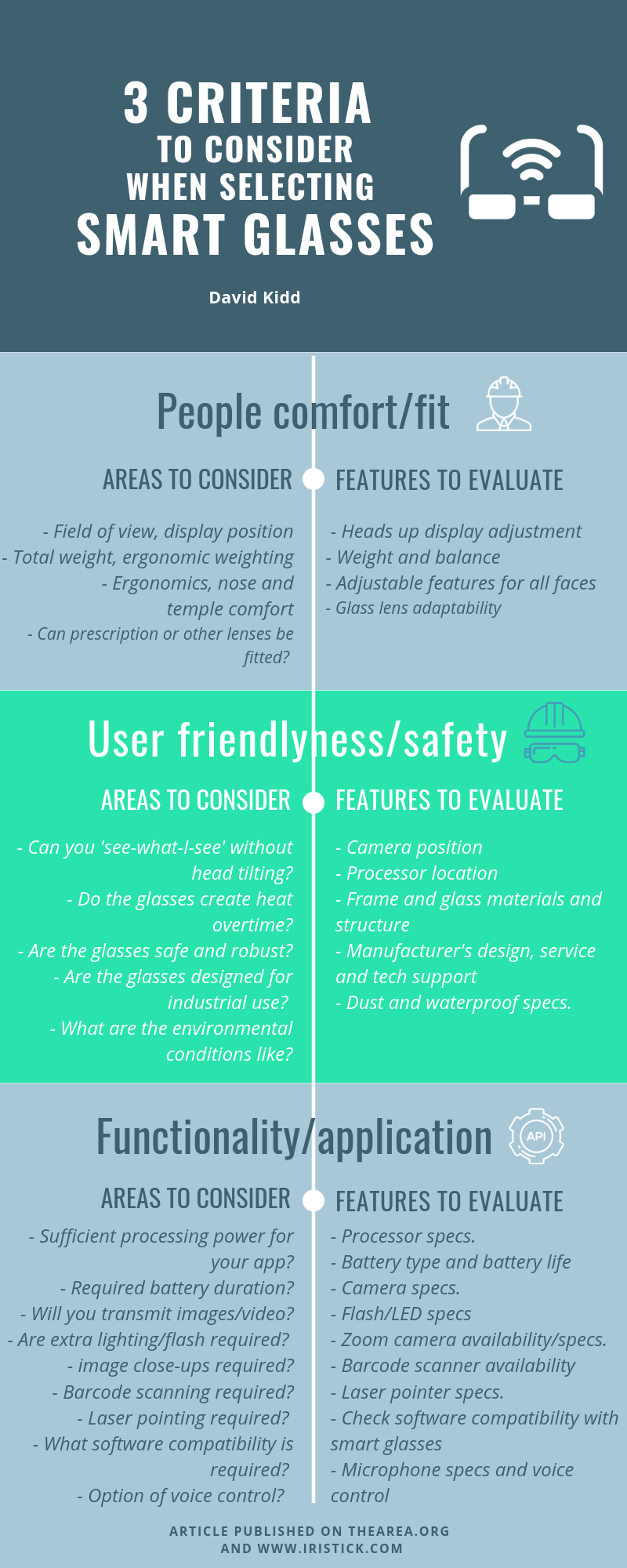Uncharted territory!
So, your company has been looking at new innovative projects with a view to driving greater efficiencies, providing superior customer service or streamlining existing work processes using the latest tried and tested technologies. A smart glasses project has been proposed based on a high return, low risk scenario.
How are you going to choose the top hardware for the job? You know the names of a few manufacturers but how do you evaluate the best hardware partner for your company project?
Proof of Concept time
At this point you will not be making final decisions as you will presumably plan a Proof of Concept project to test the hardware, the software and to validate your project hypotheses and your financial projections. Your first step will be to shortlist the two or three smart glasses of most interest to you and analyse them based on a series of criteria. You may choose to summarise and analyse these in a comparison table.
Smart glasses in various forms have been under development for many years now and the web is full of commercially-available choices. As a result, it is important to have a clear idea of the criteria to use when selecting your hardware.
Think about your people first!
First and foremost, as everyone will have told you, it is always about the use case and the application! But while you keep that front of mind how should you conduct your evaluation to identify the best product for your needs? The choice of hardware can appear daunting but let’s start by asking some simple questions.
- For how long will the glasses be worn by the user every week?
- In what environment will your staff use them? Light, noise, dust, personal safety risks?
- Will all users be carrying out the same job or will the application vary in some cases?
- What level of tech support will your individual people require as they adopt this new technology?
- Which “must-have” requirements are critical in terms of functionality for your specific project application? Don’t be distracted by other “nice to have” features.
Three key comparison criteria
In order to make the case for your product proposal, let’s identify the main factors you should think about. It’s useful to put a structure around the selection process, breaking everything down into three main areas to consider.
- PEOPLE COMFORT/FIT. If the glasses are not comfortable and easy to wear, your project investment is going to face some resistance. When implementing new technology projects, a company always runs the risk of encountering hurdles and having to overcoming obstacles that slow down the rollout process. Your people need to buy in to the project. This is a simple one but not to be underestimated. Do they feel like normal glasses or not? Will your people be happy to wear them?
- USER FRIENDLINESS/SAFETY. It goes without saying, it must be easy to interact with the glasses and allow your staff to work efficiently, while having the added advantage of working hands-free with the heads-up display. Do the glasses keep your people safe and minimise work area risks? Are the glasses suitable for the environment they will be exposed to during their useful lifetime? Are they designed for the job?
- PROJECT FUNCTIONALITY. What is the use case you are planning? What job do the glasses have to do for the operator? It is likely that the smart glasses manufacturer will have examples of similar use cases, so have a conversation about the technical specifications. The smart glasses themselves have a short and quick learning curve and so, with basic training, you should expect your staff to be able to start using the hardware very quickly. This area will also require discussions with software providers.
It’s important to tick all boxes and evaluate all three areas equally to ensure a successful project and happy users!
A useful evaluation framework

Fig.1: A framework to evaluate smart glasses
There is a fourth area of comparison which you will obviously evaluate and that is hardware unit cost and the impact the smart glasses will have on total project cost and ROI. As a general rule, smart glasses represent a relatively small percentage of total project cost, in the region of 15%-20%. As a result, it is important to select the optimal hardware partner prioritising performance over cost. Don’t go looking for false savings which can have a negative impact on project success in other areas. In addition, another element of hidden cost to investigate is the technical support and after-sales service provided by your hardware manufacturer.
Firing on all cylinders
We cannot close our discussion without also mentioning the software application which will drive your project and deliver the expected results. Whether it is managing workflows, providing work instructions, connecting remote operators, creating a shared and collaborative work space or other functionalities, your chosen software application must be available with your chosen hardware. You are buying a total solution, not single products. To ensure you achieve peak performance, your final evaluation will be based on the combination of your hardware and software solution together. Strong hardware/software partnerships help ensure your success.
If you are approaching the smart glasses market for the first time, this framework should be of some assistance.
Source: This article was written by David Kidd as a guest post on http://thearea.org/why-ar-for-...